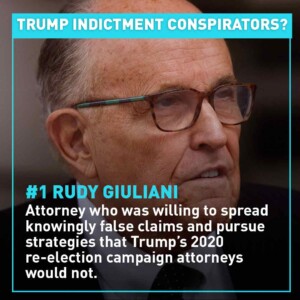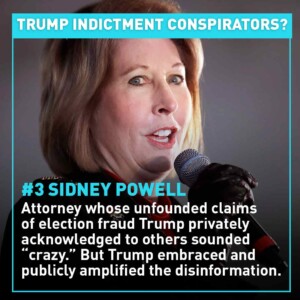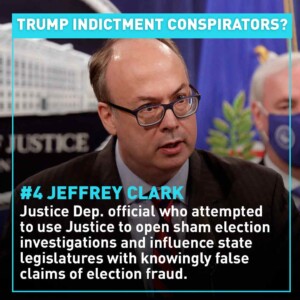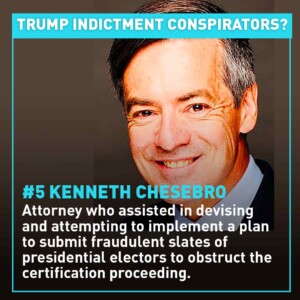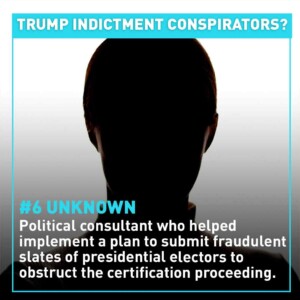The Aug. 1 Grand Jury indictment of former President Donald Trump listed six unnamed co-conspirators in Trump’s alleged conspiracy to defraud the United States in his attempt to overturn the 2020 election results.
The co-conspirators were also involved in Trump’s obstruction – and attempts to obstruct – the certification of Joe Biden on Jan. 6, 2021, and conspired to violate the right of Americans to vote and to have their vote count, the indictment says.
While unnamed and as yet un-indicted, all but one of the conspirators are identifiable based on details in the indictment. Here’s what we know so far.
Rudy Giuliani
Co-Conspirator 1, is described on the indictment as “an attorney who was willing to spread knowingly false claims and pursue strategies that the Defendant’s 2020 re-election campaign attorneys would not.”
Former New York City Mayor and Trump attorney Rudy Giuliani played a pivotal role in Trump’s attempt to overturn the election results.
Giuliani’s lawyer has said in a statement that it “appears that Mayor Giuliani is alleged to be co-conspirator No. 1.”
John Eastman
Co-Conspirator 2, is described in the indictment as “an attorney who devised and attempted to implement a strategy to leverage the Vice President’s ceremonial role overseeing the certification proceeding to obstruct the certification of the presidential election.”
Co-Conspirator 2 called the Arizona House Speaker on Jan. 4, 2021 urging him to get the legislature to decertify the official electors for the state, the indictment says.
In June 2022, then Arizona House Speaker Rusty Bowers testified to the House Select Committee to Investigate the Jan. 6 attack that Trump attorney John Eastman called him in early January asking him to schedule a vote to decertify the electors.
Bowers said that Eastman told him he should “just do it and let the courts figure it all out.”
The indictment reads: “Co-Conspirator 2 conceded that he “[didn’t] know enough about facts on the ground” in Arizona, but nonetheless told the Arizona House Speaker to decertify and “let the courts sort it out.”
The speaker refused the request, saying he wouldn’t “play with the oath” he had taken to uphold the Constitution and state law, the indictment said.
Sidney Powell
Co-Conspirator 3, is listed in the indictment as “an attorney whose unfounded claims of election fraud the Defendant privately acknowledged to others sounded “crazy.” Nonetheless, the Defendant embraced and publicly amplified Co-Conspirator 3’s disinformation.”
On Nov. 25, 2020 Co-Conspirator 3 filed a lawsuit against the Georgia governor alleging “massive election fraud” using the election software and hardware in the state’s voting machines, the indictment says.
Texas appellate lawyer Sidney Powell was on Trump’s legal team and filed the lawsuit alleging ballot fraud in Georgia’s Dominion voting machines, which was dismissed on Dec. 7, 2020.
The House Select Committee on Jan. 6 reported that Trump spoke by phone to Powell who had repeated claims of foreign interference in the election.
“While she was speaking, the President muted his speakerphone and laughed at Powell, telling the others in the room, “This does sound crazy, doesn’t it?” the select committee report says.
Trump’s indictment says that Co-Conspirator 3 repeated claims of the voting machine company in private and that Trump conceded that they were unsupported and that Co-Conspirator 3 sounded “crazy”
Jeffrey Clark
Co-Conspirator 4 is described as “a Justice Department official who worked on civil matters” who worked with Trump and attempted to use Justice to “open sham election crime investigations and influence state legislatures with knowingly false claims of election fraud.”
The indictment says that Co-Conspirator 4 met with Trump at the White House on Dec. 22, 2020 and did not tell his superiors about the meeting, which violates the Justice department’s policy restricting contact with the White House to protect against improper political influence.
When the Acting Attorney General contacted Co-Conspirator 4 about the meeting, he lied about the circumstances saying the meeting was unplanned. He was warned not to have any unauthorized contact with the White House again, the indictment says.
The House Select Committee investigation on Jan. 6, learn in its interview with then Acting Attorney General Jeffrey Rosen that Rosen had asked his Assistant Attorney General Jeffrey Clark about a meeting Clark had with Trump in December 2020.
Clark acknowledged he had been in a meeting with Trump but said he had been meeting with a Congressman and was surprised when they “somehow wound up at a meeting in the Oval Office.”
His contact with Trump violated Justice Dept. and White House policies to prevent political pressure on the department, the Select Committee report said.
Kenneth Chesebro
Co-Conspirator 5, is described in the indictment as an attorney helping Trump’s campaign with legal efforts related to the Wisconsin recount who “assisted in devising and attempting to implement a plan to submit fraudulent slates of presidential electors to obstruct the certification proceeding.”
According to the indictment, the plan was outlined in a memos that Co-Conspirator 5 drafted which then evolved from a “legal strategy” to preserve Trump’s rights “to a corrupt plan to subvert the federal government function by stopping Biden electors’ votes from being counted and certified”.
In Feb. 2022, the New York Times reported that they had obtained memos authored by attorney Kenneth Chesebro to another Trump lawyer outlining a plan to put alternate slates of electors in states Trump was hoping to overturn election results. The memos were initially to address Trump’s Wisconsin challenge, but then broadened to include a plan to use fake electors in contested states in an attempt to hold up the certification of Biden as president.
The House Select Committee on Jan. 6 also found that “Chesebro and John Eastman would build upon that framework and write two memos asserting that Joe Biden’s certification could be derailed on January 6th if Vice President Pence acted as the “ultimate arbiter’ when opening the real and fake Electoral College votes during the joint session of Congress.”
When asked about his role in these matters by the Select Committee, Chesebro invoked his Fifth Amendment rights against self-incrimination.
Unknown: Co-Conspirator 6
Co-Conspirator 6, is described as “a political consultant who helped implement a plan to submit fraudulent slates of presidential electors to obstruct the certification proceeding.”
Trump spoke with Giuliani and Co-Conspirator 6 on Dec. 7, 2020 to discuss “attorneys who could assist in the fraudulent elector effort in the targeted states, and he received from Co-Conspirator 6 an email identifying attorneys in Arizona, Georgia, Michigan, Nevada, New Mexico, Pennsylvania, and Wisconsin” the indictment says. The next day, Chesebro called the attorney in Arizona on Co-Conspirator 6’s list.
The New York Times reported on Aug. 2, 2023 that an email they reviewed on Dec. 7, 2020 between Trump’s strategic adviser Boris Epshteyn, Giuliani, and Giuliani’s son Andrew, had the subject line: ‘Attorneys for Electors Memo’ and reads “…as discussed, below are the attorneys I would recommend for the memo on choosing electors” and lists lawyers in the seven states listed in the indictment.
“The existence of the email from Mr. Epshteyn does not eliminate the possibility that someone else sent Mr. Giuliani a similar note,” the Times reported.
The House Select Committee also concluded that people including Roger Stone, Michael Flynn, Mark Meadows and others could also be subject to investigations by the Justice Dept.
The indictment says that on Dec. 12, Giuliani, Chesebro and Co-Conspirator 6, held a conference call organized by Trump’s campaign with Trump’s electors in the state. When the false electors expressed concern about signing certificates saying they were legitimate electors, Giuliani falsely told them that it would only be used if Trump succeeded in lawsuits challenging the election results in Pennsylvania.
“Subsequently, Co-Conspirator 6 circulated proposed conditional language to that effect for potential inclusion in the fraudulent elector certificates,” the indictment says.
The indictment also said that on the evening of Jan. 6 insurrection, Co-Conspirator 6 also tried to confirm phone numbers for six senators who Trump had told Giuliani to call to try to “enlist in further delaying the certification.”
 CGTN America
CGTN America
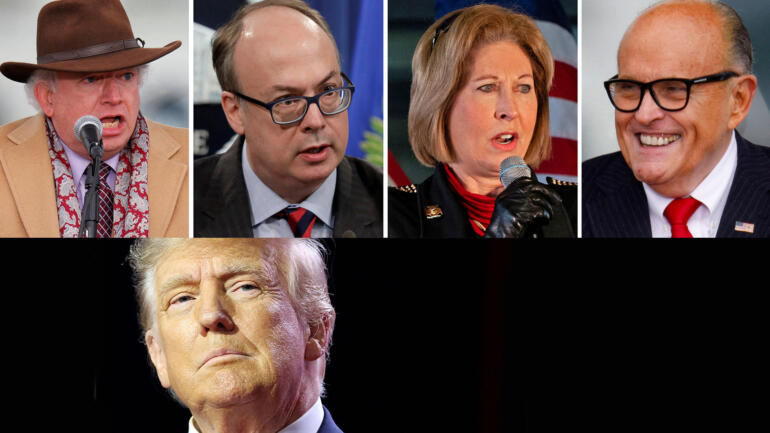 FILE PHOTO: Former U.S. President Donald Trump addresses The Faith and Freedom Coalition’s 2023 “Road to Majority” conference in Washington, U.S., June 24, 2023. REUTERS/Tasos Katopodis/File Photo
FILE PHOTO: Former U.S. President Donald Trump addresses The Faith and Freedom Coalition’s 2023 “Road to Majority” conference in Washington, U.S., June 24, 2023. REUTERS/Tasos Katopodis/File Photo
